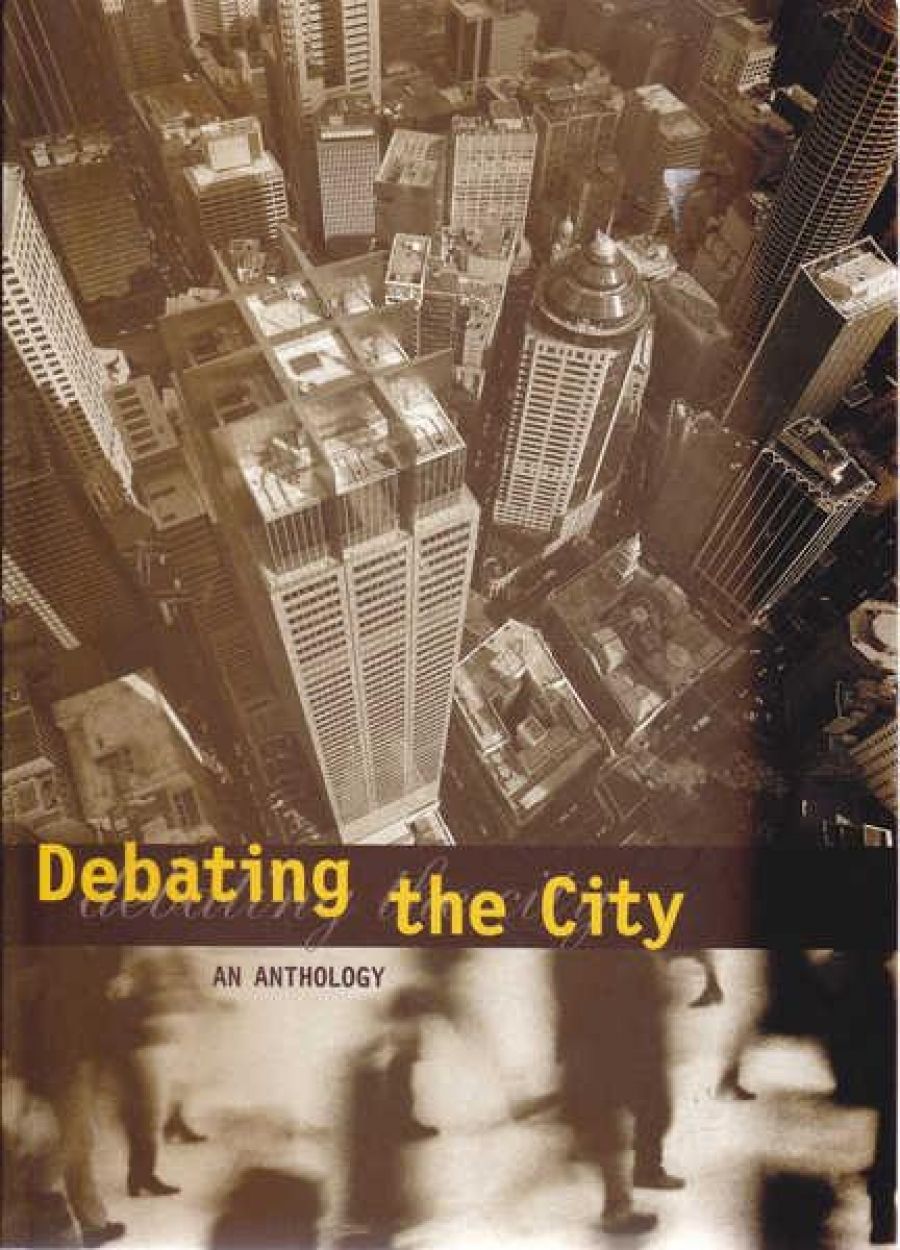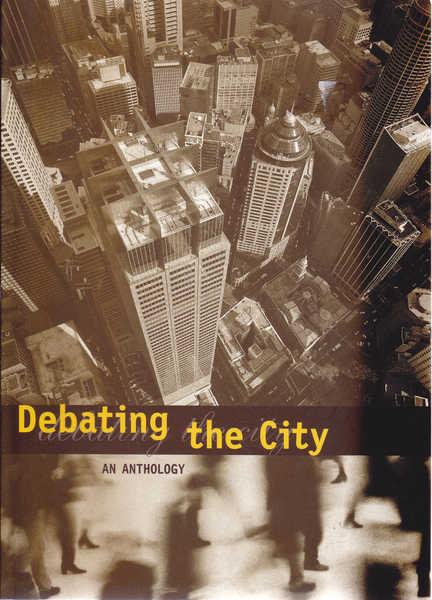
- Free Article: No
- Contents Category: Australian History
- Review Article: Yes
- Article Title: The Florence of the South
- Online Only: No
- Custom Highlight Text:
In his amusing essay, ‘The More Things Change’, John Birmingham writes:
Sydney will always confound, infuriate, engage and seduce. It is a provider/destroyer, madonna/whore and prophet of the main chance. It is hated, feted, loved and envied. It cares not. Self-obsessed and cosmopolitan, tacky, shallow and deeply serious, it knows its own worth and vainly overstates it at every turn – as when one speaker at the last (sic) Premier’s litfest dinner favourably compared the old tart with the Florence of Michelangelo. The gasps at the dinner tables were probably in surprise that anyone could think to bracket Sydney with such a provincial backwater.
While, I hope, ironic, this observation could be said to be indicative of the attitude behind many of the individual chapters in this anthology.
The book, as its editors inform us in their introduction, has grown out of a series of ‘Debating the City’ conferences held at the Museum of Sydney in 1999 and 2000. They, and the Director of the Historic Houses Trust, Peter Watts, in his foreword, are at pains to stress that this book is about cities, ‘the liveability of the modern city’ and ‘the city as an interdisciplinary subject’. However, while the conferences may have been about cities, the overwhelming number of papers selected for publication in the book take Sydney as their almost exclusive subject. In fact, eleven of the eighteen chapters are specifically about aspects of Sydney’s urban development or the experience of living in Sydney. Perhaps John Birmingham got it right.
- Book 1 Title: Debating the City
- Book 1 Subtitle: An Anthology
- Book 1 Biblio: Historic Houses Trust of New South Wales, $34.95 pb, 255 pp
- Book 1 Cover Small (400 x 600):

- Book 1 Cover (800 x 1200):

The book, as its editors inform us in their introduction, has grown out of a series of ‘Debating the City’ conferences held at the Museum of Sydney in 1999 and 2000. They, and the Director of the Historic Houses Trust, Peter Watts, in his foreword, are at pains to stress that this book is about cities, ‘the liveability of the modern city’ and ‘the city as an interdisciplinary subject’. However, while the conferences may have been about cities, the overwhelming number of papers selected for publication in the book take Sydney as their almost exclusive subject. In fact, eleven of the eighteen chapters are specifically about aspects of Sydney’s urban development or the experience of living in Sydney. Perhaps John Birmingham got it right.
Far too many of the authors are full of a self-satisfied parochialism, which allows them, when thinking and writing about cities generally, to take Sydney as the ideal and only example, not just in Australia but also the world. While Melbourne, a city with a very different and highly planned centre, is occasionally considered, and Adelaide, similarly planned, and Perth, get a couple of mentions, all too frequently it is as if Australia has only one city worthy of the description. Cities such as Ballarat, Townsville, or even Canberra, an antipodean garden city, do not rate a mention. It is the overwhelming certainty of most authors that they need look nowhere other than Sydney for inspiration and example that makes Birmingham’s anecdote so ironically amusing.
The editors claim the book is aimed at a wide readership: ‘from professionals in urban design, urban and cultural planning, cultural institutions and associated government agencies to the general public, people with an interest in the liveability of our cities today and in the future.’ However, the highly specific nature of so many of the chapters ensures that their claim to a more wide-ranging interest is unreasonably hopeful. The book’s title is unfortunate at best and at worst a deliberate attempt to appeal to a wider audience.
That said, there are some truly insightful chapters into the history of Sydney’s urban development. Ian Hoskins’s account of Cook and Phillip Parks, dedicated in 1878 and gradually eaten away by buildings until, in the rapacious 1990s, an aquatic centre, topped by a café, could be built in front of the city’s most impressive cathedral, tells us that we should not have expected otherwise. Brenda Croft’s highly personal account of coming, as recently as 1985, to live in Redfern, and Frank Alvarez’s explanation of the psychology of shopping malls, are equally informative about quite different experiences of Sydney. Marla Guppy’s description of the lessons learnt from the Living Streets Project in the outer-western Sydney suburb of Liverpool, and in other ethnically diverse suburbs, is full of lively observations and smacks of a real experience of urban living. These essays blend historical fact, observation, critical understanding and a sense of a wider context. On very specific topics, they offer valuable insights into the nature of urban development and living.
Similarly, considering both Sydney and Melbourne, Philip Goad’s comparative study of the impact of the Olympics on Melbourne in 1956 and Sydney forty-four years later, and Andrew Brown-May’s account of the coming of civilisation to these cities, in the form of the first espresso machines, are both full of information. Written with an awareness of a wider world, they restore the reader’s faith in architects and historians who have benefited from travel and the experience of cities other than Sydney and an appreciation of Australia’s place in, and relationship to, other world cities.
On the whole, though, few writers look beyond Australia. In retrospect, this makes Fran Tonkiss’s essay, ‘Inner City Living’, worthy of its opening position because it so well presents the purported subject of the book. But the rest of the writers fail to live up to the challenge, most alarmingly Jane Jacobs’s examination of the place of high-rise urban development. While seemingly an author in search of an authority figure (she cites sources as divergent as Sigmund Freud, Le Corbusier, Roland Barthes, Leonie Sandercock and Prince Charles, among others), she fails to convince that she has experienced or attempted to appreciate the differences in population, geography, ethnicity etc., which all go to make every city different. Several of the essays suggest that the over-whelming problem with urban planning is a failure to see that no two cities are the same or have even vaguely similar needs.
My judgment of this collection of essays masquerading as a book is harsh. While the editors have attempted to present the essays thematically, few have anything much to say about urban development or the nature of cities. Certainly, no debate develops about the topic. As the essays are drawn from conferences, which attracted the best in their fields from both academe and museums, the contributors fail to live up to the standards of their professions. Perhaps these papers would have been best left unpublished, the memories for those who attended the conferences.
Finally, I wonder just what the editors’ task was in assembling this anthology. More than likely they prodded and cajoled speakers into writing up their papers, but there is scant attention to uniformity of approach or grammar. I suppose I might just wish this was the last book of its kind. Why was the money wasted? In a world where institutions can seldom afford to publish books and catalogues, this book has undoubtedly taken up funds that should have been devoted to a more carefully considered publication.


Comments powered by CComment